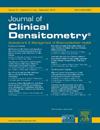Correlation of Gastrocnemius Muscle Quality With Balance, Appendicular Skeletal Mass, and Fall Risk in Osteoporotic Women: A Musculoskeletal Sonography Assessment During Rest and Activity
IF 1.6
4区 医学
Q4 ENDOCRINOLOGY & METABOLISM
引用次数: 0
Abstract
Objectives: The weakening of the musculoskeletal system in women suffering from osteoporosis often leads to an increased risk of falls. We delved into the relationship between the echo intensity (EI) of the resting and contracting medial gastrocnemius muscle (MG) and its correlation with postural sway, appendicular skeletal muscle mass index (ASMI), and the fall efficacy scale (FES) in women over 60 diagnosed with osteoporosis.
Methods: This observational-analytical study welcomed the voluntary participation of 40 women diagnosed with osteoporosis. We employed DEXA to assess ASMI, leg fat/lean-mass, and musculoskeletal sonography to measure muscle architecture and the EI of the MG muscle during both rest and activity. We determined the center of pressure sway (CoP) in the anteroposterior (AP) and mediolateral (ML) directions during the double stance position.
Results: A significant positive correlation was observed between the EI during rest and contraction with FES (r=0.527 and 0.570, respectively). An inverse correlation was noted between MG-activation EI and ASMI (r=-0.486). Interestingly, the MG-activation EI emerged as the best predictor for the sway velocity AP and ML (R2=22 % and 23 %, respectively), and sway average amplitude ML (R2=24 %).
Conclusion: It was found that gastrocnemius muscle EI during rest and activity was associated with AP/ML postural sway, ASMI, leg fat/lean-mass and FES. MG-EI, especially during activation, could be considered as a promising noninvasive marker of muscle quality with a significant association with CoP sway and fall risk in women with osteoporosis at screening.
骨质疏松女性腓肠肌质量与平衡、尾骨质量和跌倒风险的相关性:休息和活动期间的肌肉骨骼超声评估。
目的:骨质疏松症女性肌肉骨骼系统的衰弱往往导致跌倒的风险增加。我们探讨了60岁以上骨质疏松症女性静息和收缩腓肠肌内侧肌(MG)回声强度(EI)与体位摇摆、阑尾骨骼肌质量指数(ASMI)和跌倒疗效量表(FES)的关系。方法:本观察分析研究欢迎40名诊断为骨质疏松症的妇女自愿参加。我们使用DEXA评估ASMI,腿部脂肪/瘦质量,肌肉骨骼超声测量肌肉结构和MG肌在休息和活动期间的EI。我们测定了双站位时前后(AP)和中外侧(ML)方向的压力摇摆中心(CoP)。结果:休息和收缩时的EI与FES呈显著正相关(r分别为0.527和0.570)。mg活化EI与ASMI呈负相关(r=-0.486)。有趣的是,mg激活的EI是摇摆速度AP和ML (R2分别为22%和23%)和摇摆平均振幅ML (R2= 24%)的最佳预测因子。结论:休息和活动时腓肠肌EI与AP/ML姿势摆动、ASMI、腿脂/瘦质量和FES有关。MG-EI,特别是在激活期间,可以被认为是一种有希望的无创肌肉质量标志物,与骨质疏松症女性筛查时的CoP摇摆和跌倒风险有显著关联。
本文章由计算机程序翻译,如有差异,请以英文原文为准。
求助全文
约1分钟内获得全文
求助全文
来源期刊

Journal of Clinical Densitometry
医学-内分泌学与代谢
CiteScore
4.90
自引率
8.00%
发文量
92
审稿时长
90 days
期刊介绍:
The Journal is committed to serving ISCD''s mission - the education of heterogenous physician specialties and technologists who are involved in the clinical assessment of skeletal health. The focus of JCD is bone mass measurement, including epidemiology of bone mass, how drugs and diseases alter bone mass, new techniques and quality assurance in bone mass imaging technologies, and bone mass health/economics.
Combining high quality research and review articles with sound, practice-oriented advice, JCD meets the diverse diagnostic and management needs of radiologists, endocrinologists, nephrologists, rheumatologists, gynecologists, family physicians, internists, and technologists whose patients require diagnostic clinical densitometry for therapeutic management.
 求助内容:
求助内容: 应助结果提醒方式:
应助结果提醒方式:


